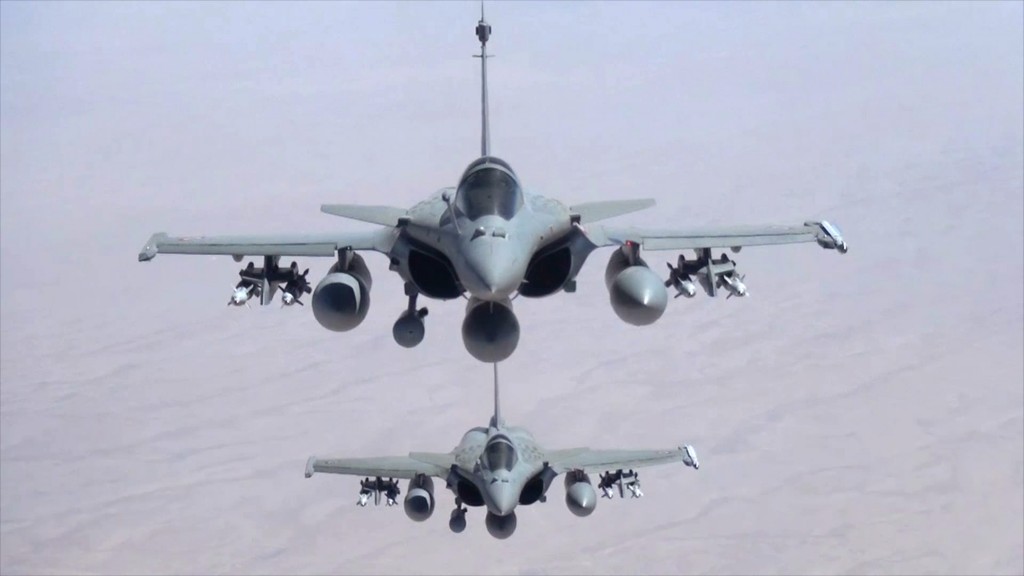- California Assembly OKs highest minimum wage in nation
- S. Korea unveils first graphic cigarette warnings
- US joins with South Korea, Japan in bid to deter North Korea
- LPGA golfer Chun In-gee finally back in action
- S. Korea won’t be top seed in final World Cup qualification round
- US men’s soccer misses 2nd straight Olympics
- US back on track in qualifying with 4-0 win over Guatemala
- High-intensity workout injuries spawn cottage industry
- CDC expands range of Zika mosquitoes into parts of Northeast
- Who knew? ‘The Walking Dead’ is helping families connect
Pentagon: US, partners begin airstrikes in Syria

Sept.19, 2014 by the French Army’s video and photo department ECPAD shows two Rafale jet fighters fly over Iraq Friday. Joining U.S. forces acting in Iraqi skies, France conducted its first airstrikes Friday against the militant Islamic State group, destroying a logistics depot that it controlled, Iraqi and French officials said. Rafale fighter jets accompanied by support planes struck the depot in northern Iraq on Friday morning, and the depot, which helped the extremist group launch operations, was entirely destroyed, President Francois Hollande said. (AP Photo/ECPAD)
WASHINGTON (AP) — The U.S. and five Arab countries launched airstrikes Monday night on Islamic State group targets in Syria, expanding a military campaign into a country whose three-year civil war has given the brutal militant group a safe haven.
Using a mix of manned aircraft — fighter jets and bombers — plus Tomahawk cruise missiles, the strikes were part of the expanded military campaign that President Barack Obama authorized nearly two weeks ago in order to disrupt and destroy the Islamic State militants, who have slaughtered thousands of people, beheaded Westerners — including two American journalists — and captured large swaths of Syria and northern and western Iraq.
U.S. officials said the airstrikes began around 8:30 p.m. EDT, and were conducted by the U.S., Bahrain, Qatar, Saudi Arabia, Jordan and the United Arab Emirates. The first wave of strikes finished about 90 minutes later, but the operation was expected to continue for several more hours, according to one U.S. official, who spoke on condition of anonymity because he was not authorized to speak publicly by name about an ongoing mission.
Because the military operation was ongoing, no details could be provided yet, said Rear Adm. John Kirby, the Pentagon’s press secretary. He said the military made the decision to strike early Monday. A White House official said Obama was being updated.
The strikes were carried out by manned Air Force and Navy aircraft, and the Tomahawk missiles were launched from U.S. ships in the northern Persian Gulf and the Red Sea. The aircraft carrier USS George H.W. Bush is in the Gulf.
Some of the airstrikes were against Islamic State group headquarters in Raqqa in eastern Syria. Military officials have said the U.S. would target militants’ command and control centers, re-supply facilities, training camps and other key logistical sites.
“We will be prepared to strike ISIL targets in Syria that degrade ISIL’s capabilities,” Army Gen. Martin Dempsey, chairman of the Joint Chiefs of Staff, told senators last week, using one of the acronyms for the Islamic State group. “This won’t look like a shock-and-awe campaign, because that’s simply not how ISIL is organized, but it will be a persistent and sustainable campaign.
Defense Secretary Chuck Hagel said that the plan “includes targeted actions against ISIL safe havens in Syria, including its command and control logistics capabilities and infrastructure.” He said he and Dempsey approved the plan.
The U.S. has also been increasing its surveillance flights over Syria, getting better intelligence on potential targets and militant movements. None of Monday’s airstrikes were from drones.
Military leaders have said about two-thirds of the estimated 31,000 Islamic State militants were in Syria.
Some officials have expressed concern that going after Islamic State militants in Syria could inadvertently help Syrian President Bashar Assad, since the militants are fighting in part to overthrow Assad.
In a speech Sept. 10, Obama vowed to go after the Islamic State militants wherever they may be. And his military and defense leaders told Congress last week that airstrikes within Syria are meant to disrupt the group’s momentum and provide time for the U.S. and allies to train and equip moderate Syrian rebels.
The U.S. military has been launching targeted airstrikes in Iraq since August, focusing specifically on attacks to protect U.S. interests and personnel, assist Iraqi refugees and secure critical infrastructure. Last week, as part of the newly expanded campaign, the U.S. began going after militant targets across Iraq, including enemy fighters, outposts, equipment and weapons.
To date U.S. fighter aircraft, bombers and drones have launched about 190 airstrikes within Iraq.
Urged on by the White House and U.S. defense and military officials, Congress passed legislation late last week authorizing the military to arm and train moderate Syrian rebels. Obama signed the bill into law Friday, providing $500 million for the U.S. to train about 5,000 rebels over the next year.
U.S. leaders have also been crisscrossing the globe trying to build a broad international coalition of nations, including Arab countries, to go after the Islamic State group and help train and equip the Iraqi security forces and the Syrian rebels.
The militant group, meanwhile, has threatened retribution. Its spokesman, Abu Mohammed al-Adnani, said in a 42-minute audio statement released Sunday that the fighters were ready to battle the U.S.-led military coalition and called for attacks at home and abroad.
___
Associated Press Writers, Julie Pace, Matthew Lee and Josh Lederman contributed to this report.















